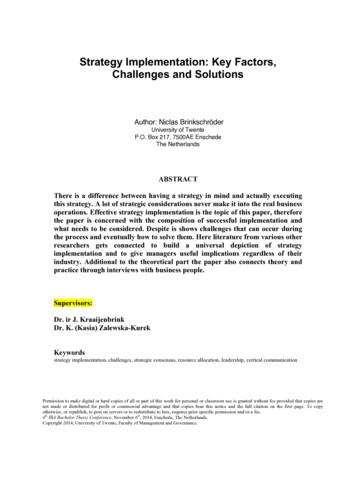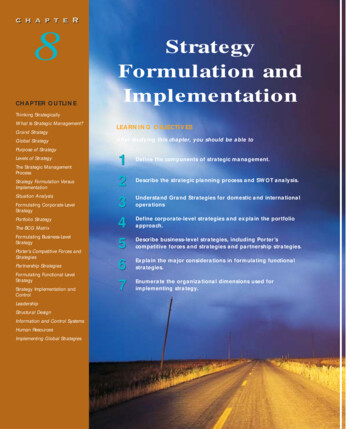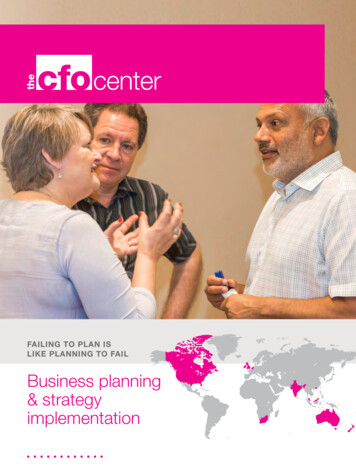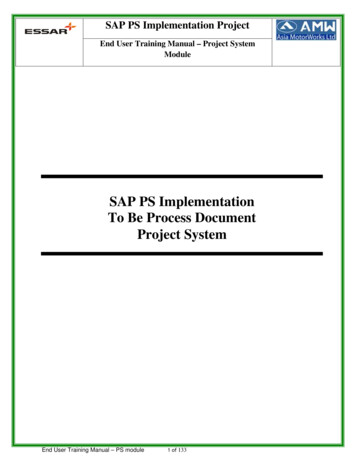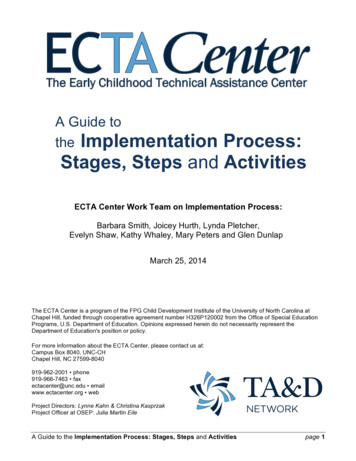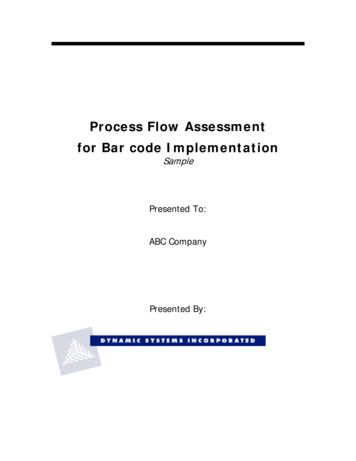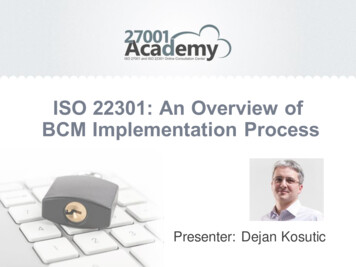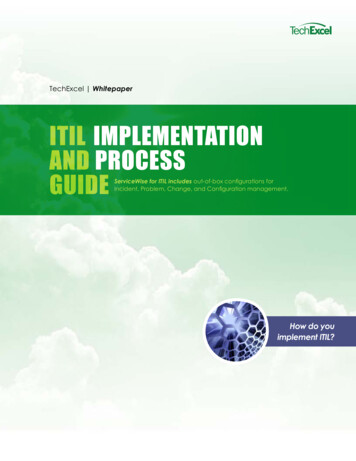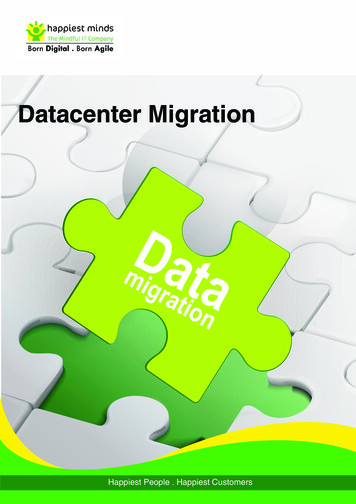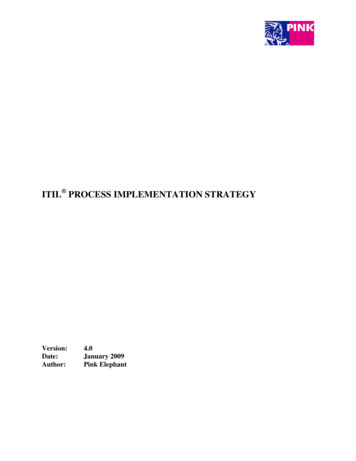
Transcription
ITIL PROCESS IMPLEMENTATION STRATEGYVersion:Date:Author:4.0January 2009Pink Elephant
Table Of Contents1PROCESS IMPLEMENTATION.31.11.22PROCESS IMPLEMENTATION PROJECTS .52.12.22.32.42.52.63PROCESS, PEOPLE & TECHNOLOGY (THE INTEGRATED PROJECT PLAN) .5IMPLEMENTATION ROLES.7PINK ELEPHANT CONSULTING ROLES .9HIGH LEVEL PROCESS MODEL DEVELOPMENT .10DETAILED DESIGN .12PROCESS ROLES & RESPONSIBILITIES .14PROCESS IMPLEMENTATION CONSIDERATIONS .183.13.23.33.44OBJECTIVE .3PROGRAM MANAGEMENT .3IMPLEMENTATION TIMES .18APPLICABILITY / SCALABILITY .18CRITICAL SUCCESS FACTORS .19MANAGEMENT COMMITMENT.20PROCESS EMBEDDING STRATEGY .214.14.2PROCESS WORKSHOPS / TRAINING .21DETAILED ACTIVITIES (PROJECT CHECK LIST) .225COMMUNICATION PLAN.256EVALUATION OF THE PROJECT.266.16.2POST-PROJECT REVIEW .26AUDITING USING QUALITY PARAMETERS .267CONCLUSION .288BIBLIOGRAPHY .299ABOUT PINK ELEPHANT .3010ITSM LEADERSHIP .31
ITIL Process Implementation Strategy1PROCESS IMPLEMENTATION1.1ObjectiveThe objective of this document is to provide guidelines for developing processimplementation plans that will be usable across a wide range of diverse organizations.The guidelines within this document are designed for use as a general roadmap, or plan,for any major process development or re-engineering project.1.2Program ManagementMany organizations that undertake programs to improve their core business processesand service delivery capabilities are frustrated by feelings of overriding failure regardingtheir ambitious goals. Or, at best, they achieve what they consider to be only minorsuccess. Much of that frustration can be directly attributed to a single, pervading factor:management’s inability to understand that when implementing processes withintraditional silo focused organizations, they are in reality changing a large part of the ITbusiness culture, roles and accountability structures.Process Reengineering Single point of accountability Logical group of activities Cross Departmental Defined procedures Repeatable, consistent Global StandardsProcessPeople Enhanced Skills Multi Functional Teams Values / Beliefs Culture biases Training Career development Mgmt. commitment Mgmt. participation Compensation / Rewards Values / Beliefs Coaching / Enabler Career opportunitiesManagementTechnology Teamwork enabled Service Management tools Integrated data sharing Knowledge Management Management Info.V 1.0Figure 1: Process Reengineering Model Pink Elephant, 2009. The contents of this document are protected by copyright and cannot be reproduced in any manner.ITIL is a Registered Trade Mark of the Office of Government Commerce in the United Kingdom and other countries.3
ITIL Process Implementation StrategyWhen mandating that departments must work at an enterprise IT level instead oftechnology-based silos (a basic process requirement) numerous fundamental changesneed to take place: Defined and repeatable cross-departmental processes need to be overlaid acrossexisting hierarchical silo-based organizational structures.The implementation of enterprise IT processes effectively creates a matrixorganization where staff have several areas of accountabilityJob Descriptions must include the new areas of responsibility and personalmeasurementValues, beliefs, and corporate cultures need to be changed from unconstructive,departmental competition, to customer-focused cooperationIT staff working within complex processes require a twofold approach to training:they need to be provided with more general knowledge and they need specific skillstraining required for specialized activitiesTo support a process approach, tools must be designed to enable collaborative teamefforts to achieve multi-process data integration and a high degree of workflowautomationManagement must sponsor new staff performance measures that reward process effortas well as silo-based departmental efficiencies.New policies must be put in place with existing staff, to clarify new expectations forperformance based on the new values surrounding process adherence, customer-basedmeasures of service delivery expectations and contracted service delivery levelsThe key element to success is the realization that the ultimate goal for any processreengineering effort is the effective sponsorship and management of organizationalchange. To address this, a formal program must be developed with all of the rigors of amajor project. Pink Elephant, 2009. The contents of this document are protected by copyright and cannot be reproduced in any manner.ITIL is a Registered Trade Mark of the Office of Government Commerce in the United Kingdom and other countries.4
ITIL Process Implementation Strategy2PROCESS IMPLEMENTATION PROJECTSAs part or our consulting engagement model, Pink Elephant follows a standardized andscalable approach for implementing ITIL processes. The model for this approach beginswith the creation of a core process design team and the identification of a larger group ofstakeholders involved in review, feedback and signoff activities. A typical project planincludes staged milestones and project activities which consider the requirements anddependence of process, people, governance, and technology.This process implementation approach is designed to facilitate a greater level of successfor project completion and process embedding. The high-level project approach providesa model for the integration and sequence of activities that characterize a successfulprocess implementation project.2.1Process, People & Technology (The Integrated Project Plan)Organizations need to take a holistic view of process implementation projects. This willensure a greater level of success for project completion and process embedding. Seriousconsideration needs to be given to the development and mapping of the three basicelements of any quality improvement initiative: process, people, governance andtechnology. To concentrate on one area to the detriment of the other can jeopardize thesuccess of the project. The following model demonstrates the integration and sequence ofactivities between process, technology and people that comprise a typical processimplementation project.Integrated Project :Governance:High LevelProcess Model Sign off& GlobalPoliciesReviewProcedures, Sign ather GeneralAutomationRequirementsBuy, Choose,Install, Configure &Test ToolsProject Teams Identify Resources &Defined ProcessRolesDetailed RolesDefinition, AuthorityMatrix & DeploymentTrainingName & EstablishService &Process OwnersDevelop Controls& ImprovementProcessesReviewDeploy &ScaleReviewLab basedProcess & ToolWorkshopsSign Off OnProductionProcessesSign offAwareness Campaign, ITIL Training, Organizational and Behavioral ChangeFigure 2: Integrated Process Implementation Model Pink Elephant, 2009. The contents of this document are protected by copyright and cannot be reproduced in any manner.ITIL is a Registered Trade Mark of the Office of Government Commerce in the United Kingdom and other countries.5
ITIL Process Implementation StrategyAs can be seen from the model above, process implementation requires a complex,integrated and multi faceted set of activities that warrant the use of a formal projectmethodology. The section below (2.6 Process Roles and Responsibilities) will discuss therecommended formal role that should be established to manage process implementationprograms.The implementation of each ITIL process follows the model depicted in Figure 2 above.The scope of this document covers the development of IT Service Managementprocesses.2.1.1Project TimelinesBased on Pink’s experience, a typical project in a single location will take between fourto six months to complete based on the model illustrated above. The reasons for thisduration are related to several factors:1. Internal resources are typically assigned to projects in a part-time capacity with atbest, two to three days a week being made available for status and design meetings aswell as the creation of deliverables.2. If process implementation is fundamentally about organizational change, then it isnecessary to build activities into the project timelines that are focused on receivingfeedback and signoff from process stakeholders so that the organizational context ofthe project is continually acknowledged. Actual design and creation of deliverablesshould constitute approximately a third of the time required to implement a reengineered process. Most organizations that discount consensus building will findthat processes designed without involvement from stakeholders will meet with a highlevel of resistance and will most likely fail.3. It is necessary to staff the core process team with diverse members from allstakeholder groups in order to accommodate the complexities of running a processimplementation initiative that incorporates strong, cross-departmental or regionalparticipation. The added expense and time involved in travel and logistics associatedwith these projects requires a creative use of physical as well as virtual participationregarding design and feedback activities. Coordinating the logistics and tools requiredto facilitate this level of involvement can add several months to the duration of theproject overall. Typically a core team will be brought together more frequently at thebeginning of a project and can then work in a more virtual mode as the projectprogresses.Project timelines cannot be met until the following can be confirmed: Establishment of Executive Sponsorship and Process OwnersApproval of budget for internal and external resources over the twelve month periodAvailability of funds for tool selection and customization according to the ITILprocesses being designed and implemented Pink Elephant, 2009. The contents of this document are protected by copyright and cannot be reproduced in any manner.ITIL is a Registered Trade Mark of the Office of Government Commerce in the United Kingdom and other countries.6
ITIL Process Implementation Strategy Existence of the political will to define new ongoing roles for process managementand coordinationConstruction of small core teams from internal resourcesAllocation of core team members as dedicated resources to their respective projectsfor a minimum of two or three days per weekExpected Project Deliverables: Documented and agreed goals and objectives for implementing the processDocumented and agreed process and proceduresDocumented and agreed process policiesAutomation requirements defined and customized according to technologyavailability and constraintsDocumented and agreed awareness campaign and training activities for processimplementation.Documented and agreed management reports and key performance indicatorsDocumented and agreed ongoing roles and responsibilities for the management andcontinued ownership and improvement of the process2.2Implementation RolesThe following section represents the typical roles required for a process implementationprogram.2.2.1Process OwnerThe initial planning phase of an ITIL program must include the establishment of the roleof process owner. This key role is accountable for the overall quality of the process andoversees the management of, and organizational compliance to, the process flows,procedures, models, policies, and technologies.The process owner performs the essential roles of process champion, design lead,advocate, and coach. Typically, a process owner should be a senior level manager withcredibility, influence and authority across the various areas impacted by the activities ofthe process. The process owner must have the ability to influence and assure complianceto the policies and procedures put in place across the cultural and departmental silos ofthe IT organization.The Process Owner’s job is not necessarily to do the actual hands-on processreengineering but to ensure that it gets done. Process Owners typically assemble theproject team, obtain the resources that the team requires, protect the team from inter
ITIL is a Registered Trade Mark of the Office of Government Commerce in the United Kingdom and other countries. As can be seen from the model above, process implementation requires a complex, integrated and multi faceted set of activities that warrant the use of a formal project methodology. The section below (2.6 Process Roles and Responsibilities) will discuss the recommended formal role .
